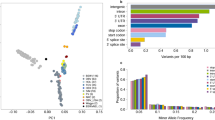Abstract
Exon 2 and intron 2 of the HLA DQB1 gene from 20 individuals were cloned and sequenced and eight alleles were obtained. Based on our analysis, the nucleotide diversity of the 5′ end of intron 2 was higher than the synonymous nucleotide diversity of exon 2, which may be due to the lower GC content and the 'hitch-hiking effect'. In contrast, the opposite phenomenon was observed for the 3′ end of intron 2, which may be the result of the recombination between the 3′ end and 5′ end of intron 2 and the subsequent genetic drift. The results indicated that different regions of intron 2 in the DQB1 gene had different evolutionary patterns.




Similar content being viewed by others
References
Apple RJ, Erlich HA (1996) HLA class II genes: structure and diversity. In: Browning MJ, McMichael AJ (eds) HLA and MHC: genes, molecules and function. BIOS Scientific, Oxford, pp 101–105
Ayala FJ (1995) The myth of Eve: molecular biology and human origins. Science 270:1930–1936
Ayala FJ, Escalante AA (1996) The evolution of human populations: a molecular perspective. Mol Phylogenet Evol 5:188–201
Beck S, Abdulla S (1991) Evolutionary dynamics of non-coding sequences with the class Ⅱ region of the human MHC. J Mol Biol 255:1–13
Bergström TF, Josefsson A, Erilich HA, Gyllensten U (1998) Recent origin of HLA-DRB1 alleles and implications for human evolution. Nat Genet 18:237–252
Brown JH, Jardetzky TS, Gorga JC, Stern LJ, Urban RG, Strominger JL, Wiley DC (1993) Three-dimensional structure of the human class Ⅱ histocompatibility antigen HLA-DR1. Nature 364:33–39
Cereb N, Hughes AL, Yang SY (1997) Locus specific conservation of the HLA class Ⅰ introns by intra-locus homogenization. Immunogenetics 47:30–36
Charlesworth B, Morgan MT, Charlesworth D (1993) The effect of deleterious mutations on neutral molecular variation. Genetics 134:1289–1303
Doherty PC, Zinkernagel RM (1975) Enhanced immunologic surveillance in mice heterozygous at the H-2 gene complex. Nature 256:50–52
Felsenstein J (1985) Confidence limits on phylogenies: an approach using the bootstrap. Evolution 39:783–791
Garrigan D, Edwards SV (1999) Polymorphism across an exon-intron boundary in an avian MHC class Ⅱ B gene. Mol Biol Evol16:1599–1606
Gaudieri S, Dawkins RL, Habara K, Kulski JK, Gojobori T (2000) SNP profile within the human major histocompatibility complex reveals an extreme and interrupted level of nucleotide diversity. Genome Res 10:1579–1586
Horton R, Niblett D, Milne S (1998) Large-scale sequence comparisons reveal unusually high levels of variation in the HLA-DQB1 locus in the class Ⅱ region of the human MHC. J Mol Biol 282:71–97
Hughes AL (2000) Evolution of introns and exons of class Ⅱ major histocompatibility complex genes of vertebrates. Immunogenetics 51:473–486
Hughes AL, Nei M (1988) Pattern of nucleotide substitution at major histocompatibility complex class Ⅰl loci reveals overdominant selection. Nature 335:167–170
Hughes AL, Nei M (1989) Nucleotide substitution at major histocompatibility complex classⅡ loci: evidence for overdominant selection. Proc Natl Acad Sci 86:958–961
Hughes AL, Yeager M (1998) Natural selection at major histocompatibility complex loci of vertebrates. Annu Rev Genet 32:415–435
Jukes T, Cantor CR (1969) Evolution of protein molecules. In: Munro HN (ed) Mammalian protein metabolism. Academic Press, New York, pp 21–132
Kaplan NL, Hudson RR, Langley CH (1989) The "Hitchhiking Effect" revisted. Genetics 123:887–899
Kumar S, Tamura K, Jakobsen IB, Nei M (2001) MEGA2: Molecular Evolutionary Genetics Analysis software. Arizona State University, Tempe, Arizona, USA
Nei M, Gojoborl J (1986) Simple methods for estimating the numbers of synonymous and nonsynonymous nucleotide substitutions. Mol Biol Evol 3:418–426
Rozas J, Rozas R (1999) DnaSP version 3: an integrated program for molecular population genetics and molecular evolution analysis. Bioinformatics 15:174–175
Saiton N, Nei M (1987) The neighbor-joining method: a new method for reconstruction phulogenetic trees. Mol Biol Evol 4:406–425
Smith JM, Haigh J (1974) The hitch-hiking effect of a favourable gene. Genet Res 23:23–35
The MHC Sequencing Consortium (1999) Complete sequence and the gene map of a human major histocompatibility complex. Nature401:921–923
Thompson JD, Gibson TJ, Plewniak F, Jeanmougin F, Higgins DG (1997) The CLUSTAL-X windows interface: flexible strategies for multiple sequences alignment aided by quality analysis tools. Nucleic Acids Res.25:4867–4882
Wolfe KH, Sharp PM, Li WH (1989) Mutation rates differ among regions of the mammalian genome. Nature 337:283–285
Yeager M, Hughes AL (1999) Evolution of the mammalian MHC: natural selection, recombination, and convergent evolution. Immunol Rev 167:45–58
Acknowledgements
All the experiments comply with the regulations in China. The research was supported by a "National Outstanding Young Scientist Award" (No. 39725007) and project grants (No. 30178073 and 30100275) of the National Natural Science Foundation of China.
Author information
Authors and Affiliations
Corresponding author
Rights and permissions
About this article
Cite this article
Fu, Y., Liu, Z., Lin, J. et al. Extensive polymorphism and different evolutionary patterns of intron 2 were identified in the HLA-DQB1 gene. Immunogenetics 54, 761–766 (2003). https://doi.org/10.1007/s00251-002-0523-z
Received:
Revised:
Published:
Issue Date:
DOI: https://doi.org/10.1007/s00251-002-0523-z




